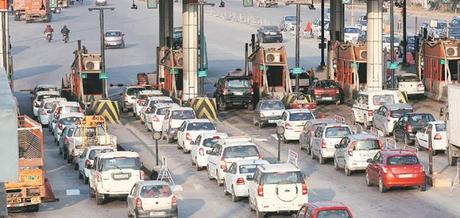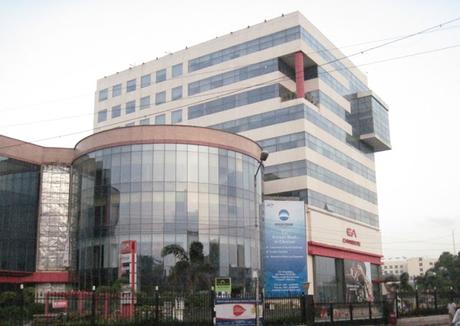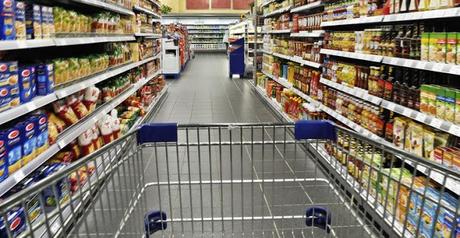There is traffic everywhere ~ on week ends and on festival days, so many people are travelling – at every toll-plaza there are long winding queues and some try to outwit others by jumping lanes and creating chaos ! .. .. RFID is in news ..Radio-frequency identification (RFID) uses electromagnetic fields to automatically identify and track tags attached to objects. The tags contain electronically stored information.
 Unlike a barcode, the tags don't need to be within the line of sight of the
reader, so it may be embedded in the tracked object. Operated by the National Highway Authority of
India, FastTAG is an electronic toll collection system that allows you to make
automatic toll payments directly from your linked account, through Radio
Frequency Identification Technology. FastTAG
will allow you to make payments at toll plazas electronically where a scanner
detects the tag and automatically deducts the toll amount from passengers’
e-wallets. The device is attached to the vehicle’s windscreen allowing
passengers to pass through without stopping. Once you pass through a tollbooth,
you receive an SMS stating the deducted amount.
Unlike a barcode, the tags don't need to be within the line of sight of the
reader, so it may be embedded in the tracked object. Operated by the National Highway Authority of
India, FastTAG is an electronic toll collection system that allows you to make
automatic toll payments directly from your linked account, through Radio
Frequency Identification Technology. FastTAG
will allow you to make payments at toll plazas electronically where a scanner
detects the tag and automatically deducts the toll amount from passengers’
e-wallets. The device is attached to the vehicle’s windscreen allowing
passengers to pass through without stopping. Once you pass through a tollbooth,
you receive an SMS stating the deducted amount.

Science and technology have changed the way people shopped. Gone are the days when you waited patiently in your neighbourhood grocery shop – the man loudly repeating every item you ordered and then writing a slip of paper the values to be paid ! .. now you push a cart around, pick-up all wanted & unwanted – at the counter, scanner will read the barcodes, there would be a beep sound, billing happens ~ in the end, one would never know – what was billed, how much one had to pay, and what was the discount bragged about ! A life without barcodes is hard to imagine now. But it wasn’t that long ago, and the story doesn’t start with George Laurer. It starts with an engineer named Joseph Woodland. In 1948 Woodland was trying to come up with simple symbol that, when scanned, would translate to a number that a computer could use to identify a product. A barcode (also spelled bar code) is a method of representing data in a visual, machine-readable form. Initially, barcodes represented data by varying the widths and spacings of parallel lines. These barcodes, now commonly referred to as linear or one-dimensional (1D), can be scanned by special optical scanners, called barcode readers. Later, two-dimensional (2D) variants were developed. 2D barcodes can be read or deconstructed using application software on mobile devices with inbuilt cameras, such as smartphones.Would you know that manually reading a barcode too is possible, but only when one understand that the 12 numbers represent. The row of numbers found on a barcode is known as the Global Trade Item Number (GTIN).
While a barcode only holds information in the horizontal direction, a QR code does hold information in both horizontal and vertical directions. Due to this, a QR code holds hundreds of times more information than a barcode. The tale of the barcode's invention begins in 1948, on a beach in Miami. Its inventor, Joseph Woodland, was thinking of Morse code and tracing circles in the sand at the time, reports 99% invisible. But Woodland's patent didn't make much of a splash until 1973. The executives approached 14 companies to come up with a solution. And as it turns out, it was an IBM employee named George Laurer who came up with the final design. The very first barcodes were in the shape of a bulls-eye, though they weren’t called “barcodes” yet. Woodland’s invention was patented in 1952 as a “Classifying Apparatus and Method”. Finally, in 1973, a group of supermarket executives led by Alan Haberman decided they needed to get some kind of scannable symbol in place to move people through checkout lines faster. They laid out a list of specifications that their ideal symbol would have and asked 14 companies, including IBM, to come up with a solution.
 George
Laurer was working at IBM at the time and was tasked with making Woodland’s circular
“Classifying Apparatus and Method” work. But Laurer didn’t think the bulls-eye
would fulfill the specifications set forth by the grocery industry. So he set
out to make something that would. Eventually, Laurer came up with a rectangular
design that fit more code into less space and didn’t smear on the presses (like
Woodland’s bulls-eye symbol did).The
“Symbol Selection Committee” voted unanimously for Laurer’s rectangular symbol
and code, which they named the Universal Product Code, or UPC.A year later, in 1974,a pack of Wrigley’s chewing gum became the
first item to be scanned with a UPC barcode. According to GS1 (Global Standards One), the agency which
issues barcode numbers, there are now about 5 billion barcodes scanned every
day around the world.
George Laurer, the
US engineer who helped develop the barcode, has died at the age of 94. Laurer
died last Thursday at his home in Wendell, North Carolina, and his funeral was
held on Monday.
With regards – S.
Sampathkumar
10th Dec
2019.
George
Laurer was working at IBM at the time and was tasked with making Woodland’s circular
“Classifying Apparatus and Method” work. But Laurer didn’t think the bulls-eye
would fulfill the specifications set forth by the grocery industry. So he set
out to make something that would. Eventually, Laurer came up with a rectangular
design that fit more code into less space and didn’t smear on the presses (like
Woodland’s bulls-eye symbol did).The
“Symbol Selection Committee” voted unanimously for Laurer’s rectangular symbol
and code, which they named the Universal Product Code, or UPC.A year later, in 1974,a pack of Wrigley’s chewing gum became the
first item to be scanned with a UPC barcode. According to GS1 (Global Standards One), the agency which
issues barcode numbers, there are now about 5 billion barcodes scanned every
day around the world.
George Laurer, the
US engineer who helped develop the barcode, has died at the age of 94. Laurer
died last Thursday at his home in Wendell, North Carolina, and his funeral was
held on Monday.
With regards – S.
Sampathkumar
10th Dec
2019.

